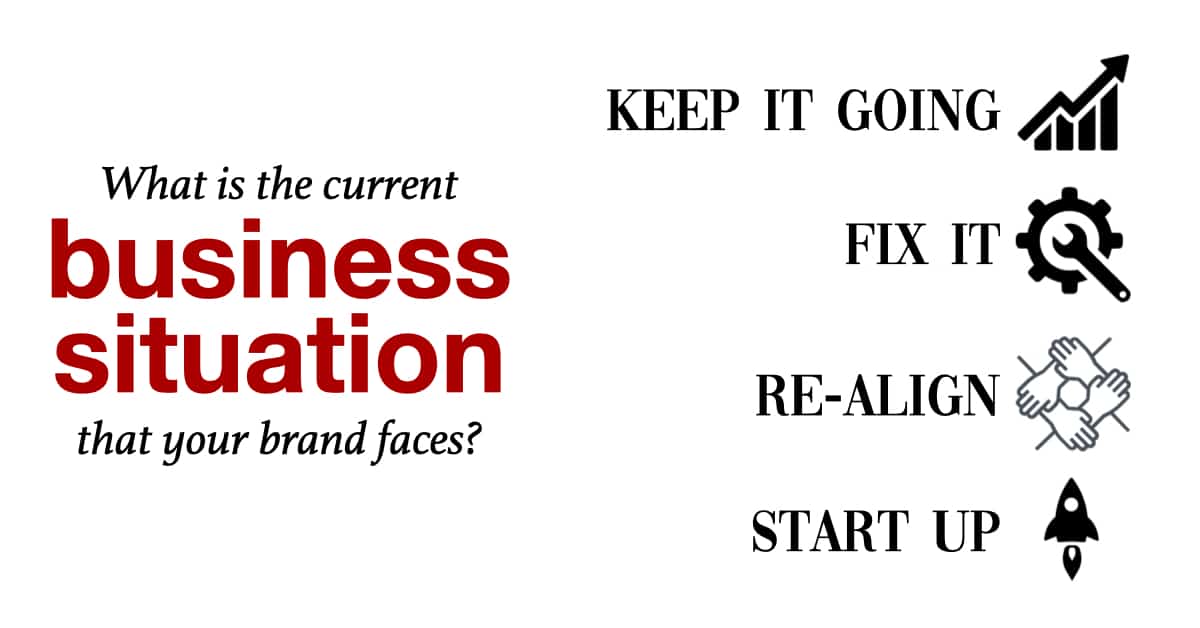I always believe strategic thinkers see questions before they see answers. With that in mind, I want to introduce a process for you to discover and narrow down the best questions you can ask. Michael Porter describes how strategy must be based on the situation and unique circumstances. So, let’s show you how to dig in and find those key issue questions that will help identify the unique circumstances facing a brand. These key issue questions are the foundation of any strategic plan. Our Strategic ThinkBox tool helps you ask tough, interruptive questions about your brand’s core strength, consumer bond, competitive dynamic, and business situation.
Using brand analytics to inform strategy
To start, you need to conduct a situation analysis
Before you plan where to go next, you need to understand, “Where are we?” A deep-dive business review should take a 360-degree view to dig into the issues related to the marketplace, consumers, competitors, channels, and the brand.
SWOT assessment
For the brand plan, provide a summary of the factors driving the brand’s growth, the factors inhibiting the brand’s growth, the untapped opportunities, and the potential threats you see.
To illustrate, click on the SWOT assessment model to zoom in.
First, the drivers are the factors of strength or inertia, which are currently accelerating your brand’s growth. These are brand assets, successful programs, favorable consumer, technology, and channel trends. Drivers also include new products, successful advertising, and performance in retail channels.
Next, the inhibitors are the factors of weaknesses or friction that slow down your brand’s growth. These are the “Achilles heel” of the brand, which could include unfavorable consumer trends, changes in the way people shop, competitive pressures, and even gaps compared to your competitors.
Then, the opportunities are specific untapped areas in the market that could fuel future brand growth. They include unfulfilled consumer needs, new technologies on the horizon, regulation changes, competitive openings, new distribution channels, or the removal of trade barriers.
Finally, the threats are identifiable activities that could impact your brand’s growth in the future. These include significant competitive activity, competitive technology gains, changing consumer dynamics, unfavorable distribution changes, or future potential trade barriers, which would impact your brand’s growth.
While you brainstorm a long list, narrow your focus to the top three points for each of the four areas. As you move from the analysis to the issues, ensure you find a way to continue or enhance the drivers, while you minimize or reverse the inhibitors. You also want to build specific plans to take advantage of the opportunities and reduce or eliminate the most severe threats.
Take your brand knowledge to new heights with our Beloved Brands playbook
Beloved Brands is a comprehensive guide that covers the fundamentals of brand management. It goes deep on strategic thinking, brand positioning, brand plan development, advertising decisions, media planning, marketing analytics, and the brand financials. This is an opportunity to build your marketing skills to help your career. And, it will provide you with the roadmap for driving growth on your brand.

Marketers see Beloved Brands playbook as a go-to resource, as they keep it within arm’s reach for any new project. We are thrilled to see that it has received a 5-star rating from nearly 90% of Amazon reviewers. Additionally, we have also created playbooks for B2B Brands and Healthcare Brands, catering to specific industries.
To me, the key issues and strategies are the guts of your plan.
Take all your thinking on your brand and start organizing the best strategic questions and answers. The key issues answer, “Why are we here?” Then, use the summary findings of the deep-dive analysis. Draw out the significant issues that are in the way of achieving your stated brand vision.
Our methodology for finding key issues is to use our Strategic ThinkBox with my four strategic questions model from the strategic thinking chapters. Our Strategic ThinkBox ensures you take a 360-degree view of your brand—your brand’s strength, consumer bond, competitive dynamic, and business situation.
- First, what is the core strength that will help your brand win?
- Second, how tightly connected is your consumer to your brand?
- Third, what is your current competitive position?
- Finally, what is the current business situation your brand faces?
To illustrate, click on the Strategic ThinkBox model to zoom in.
With each of these four questions, you need to decide on your main answer and see if your investments, communications, and execution deliver on that answer. Once we have the issues expressed as questions, we can provide our strategic solutions for Gray’s Cookies.
What is your brand’s core strength?
Engage our core strength model to trigger your strategic thinking mindset.
Here is the game I have created to help choose your brand’s core strength. Use the diagram above, start with four chips. You must place one chip where you believe you have the highest competitive advantage to win. Then, put two chips at the medium level that backs up and supports the core strength. Finally, the game forces one chip to be at the low end. This is a throwaway weakness that will not be part of the strategy. It is a great game to try with your team. And, it sets up a great debate among your team members. To read more, click on this link: How to find your brand’s core strength.
To illustrate, click on the core strength model to zoom in.
How to interrogate your brand using our core strength.
First, do the homework to discover your core strength. Next, we need to figure out what the underlying issues related to that core strength. Here are four questions that will trigger your strategic thinking.
- First, is your core strength the product, story, experience, or price? Are you lined up with it?
- Second, where are you investing? What has paid off or not?
- Third, are you communicating your core strength? Are you moving consumers?
- Finally, what is working well? What needs fixing?
Example of how to discover the key issues surrounding Gray's Cookies related to the core strength.
Gray’s Cookie started as a product-led brand, but it met a ceiling on growth. The market is cluttered. There are signs that consumers accepted the product, but the brand idea has yet to connect. Gray’s cannot gain enough share if perceived as the best product. The open space is an idea that combines the physical and psychological elements of diets—focusing the brand story on helping get past the guilt of cravings. How do we communicate our brand story, so we own it?

How tight is the brand's bond with consumers?
Engage our brand love curve model to trigger your strategic thinking mindset.
Marketers need to use consumer strategy to tighten the bond with consumers, to provide more power and set up the potential to drive added revenue and profits. To show the differences in how consumers feel about a brand as they move through five stages, I created the brand love curve. It defines consumers’ feelings as unknown, indifferent, like it, love it and onto the beloved brand status. To read more, click on this link: How to map out your consumer strategy.
To illustrate the consumer strategy model, click to zoom in.
How to interrogate the consumer bond of your brand.
First, do the homework to discover how tight is the bond with your consumers. Next, we need to figure out what the underlying issues related to consumers. Here are four questions that will trigger your strategic thinking.
- First, where are you on the brand love curve. Is your brand unknown, indifferent, liked, loved, or beloved?
- Second, do you know the consumer target, knowledge, insights, match with benefits?
- Third, what triggers consumers to move along their journey?
- Finally, what does the brand funnel indicate? Penetration, frequency?
Example of how do discover the key issues surrounding Gray's Cookies related to the core strength.
Like many new brands, Gray’s Cookies has some consumers who love them already, but Gray’s is unknown with the vast majority of the market. Even with those who love, stated loyalty is high, but usage frequency is far below the mainstream cookies. Do we focus our investments on getting more new consumers, or do we get our current fans to use more? How do we use our brand fans to create more awareness?

What is your current competitive position?
Engage our competitive strategy model to trigger your strategic thinking mindset.
Our competitive strategy model lays out four types of competitive brand strategy situations: the power player, challenger brand, disruptor brand, and craft brand. To start, try to identify and choose one competitive situation that best fits where you are today and where you want to go next.
To illustrate the competitive strategy model, click to zoom in.
How to interrogate the competitive situation of your brand.
First, do the homework to discover which competitive situation best suits where you are today. Next, we need to figure out what the underlying issues related to competitors. Here are four questions that will trigger your strategic thinking.
- First, is your brand the power player, challenger, disruptor, or craft brand?
- Second, what is the unique positioning space you win with?
- Third, what is the intensity of competition? Are you attacking or defending?
- Finally, are you winning battles: investment, messages, innovation, retail, location?
Example of how do discover the key issues surrounding Gray's Cookies related to the competitive situation.
Gray’s has quickly disrupted the cookie category, capturing the consumer shift to healthier alternatives. Gray’s has become the dominant power player brand in the ‘good-for-you’ cookie segment. However, there are rumors that the mainstream brands (Nabisco, Pepperidge Farms) are looking to enter healthier alternatives. How do we hang onto our share? Do we attack or defend? What will be the source of the defence plan?
What is your business situation?
Understand your business situation before making your next move.
A smart brand strategy is a smart business strategy. Before moving towards a plan, you must understand the business situation you face. In this article, I will outline four distinct business situations your brand could face: Fuel the momentum, Fix it, Realignment, and a Start-up. You are running a live business, with a need to drive sales, manage costs, and produce profits. Importantly, you should do a deep-dive business review to understand what’s going on. Moreover, you need to understand your profit situation.
To illustrate, click on the Key Issues to zoom in on the strategic thinking.
How to interrogate the business situation of your brand.
First, do the homework to discover which business situation best suits where you are today. Next, we need to figure out what the underlying issues related to your business situation. Here are four questions that will trigger your strategic thinking.
- First, what is your business situation? Continue momentum, turnaround results, realignment, or startup?
- Wealth: share, sales, profits? Health: reputation, distribution, pipeline?
- Then, what are the significant gaps that need fixing: message, distribution, innovation?
- Finally, what are the current drivers and inhibitors? Future opportunities and threats?
Example of how do discover the key issues surrounding Gray's Cookies related to the business situation.
Gray’s must maintain momentum as it continues to grow. Now is the time to start filling in some of the gaps early on. As we keep investing in advertising, we need to shore up our distribution, especially at the non-food retailers such as Costco, Walmart, and drug stores. We need to do that before the competitors come in, or we will never get that distribution.
Narrowing down to the key issues you are facing
Based on all your strategic thinking, now you need to transform that thinking into the best strategic key issue questions.
To illustrate, click on the Key Issues to zoom in on the strategic thinking.
Looking at the example above, I have used the four Strategic ThinkBox questions to trigger my thinking, and then I developed four specific questions that fit the unique situation facing Gray’s Cookies.
You may end up with multiple key issue questions matched up to one of the ThinkBox questions, or you may end up with redundant questions. With various ways to brainstorm and find the issues I recommend for the annual brand plan, focus on the top three key issues, which set up the top three strategies. A long-range strategic roadmap can typically handle five key issues and then five strategies.
Make sure you find the right level of the key issue
Too low: How do we get consumers to use more coupons?
- In this example, the key issue is too specific and too tactical to set up a strategic solution.
Too high: How do we become the #1 brand?
- This key issue is too general and too broad of a question to lead to a pinpointed, strategic solution. It is more suited to a question on brand vision.
Just right: How do we drive usage among loyal consumers?
- With this example, the key issue does an excellent job of addressing an obstacle in the way of the vision, yet it is big enough to leave you sufficient room to explore various strategic solution
Video Lesson: Key Issues
To illustrate, watch our video on how to find the key issues on your brand that you can use in your marketing plan. Importantly, it helps you find the best possible questions. Subsequently, it sets up strategic solutions to answer those questions.
To view, use the ▶️ controls to play our brand strategy video.



















